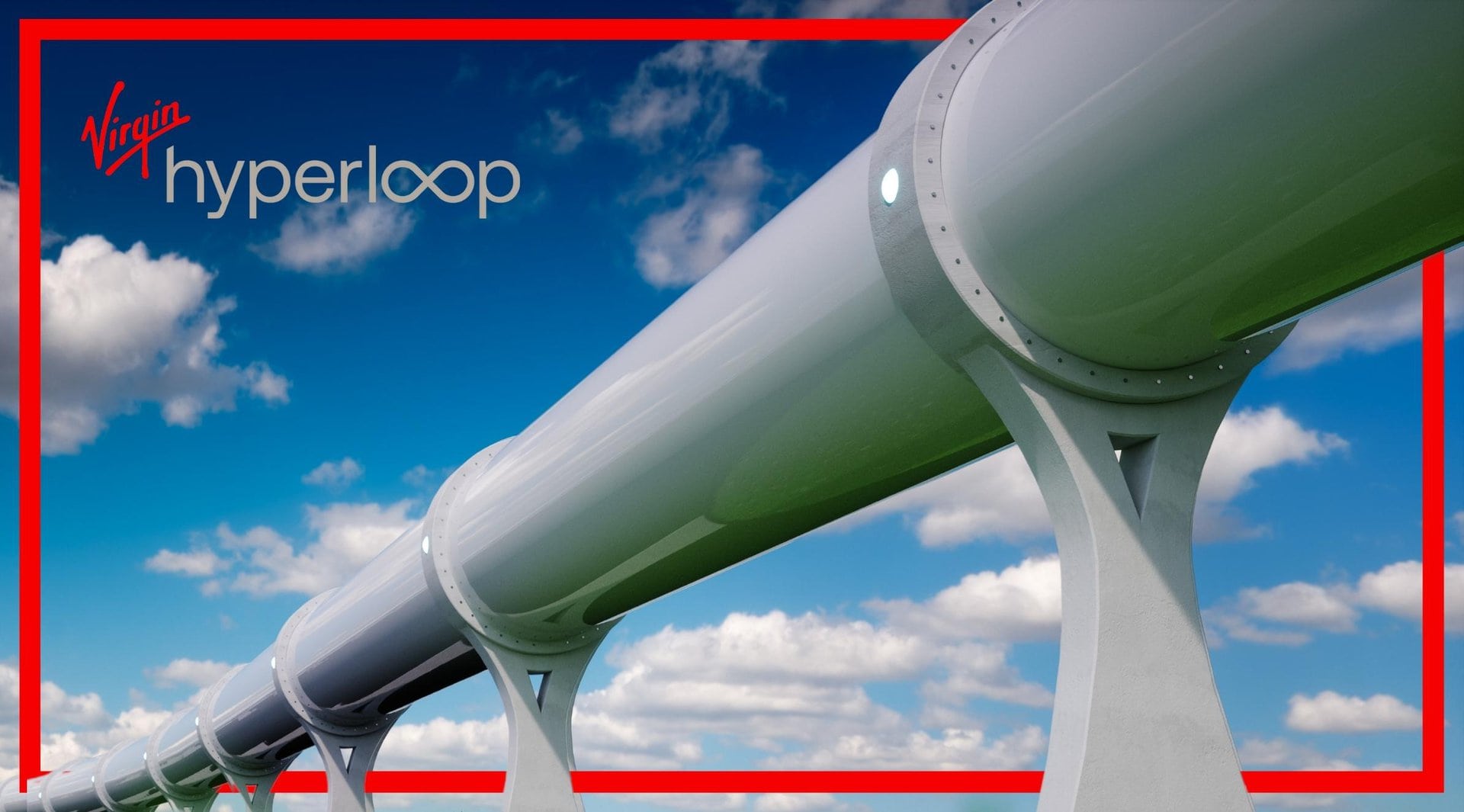600 miles per hour through a metal tunnel doesn’t feel like it does 37,000 feet above. Free of the majority of noise, air resistance and turbulence, the journey is as close as one can feel to gliding. There are no windows and so, as the small dot on your screen drifts between cities, you simply have to imagine the towns flying by outside. This is the dream that Hyperloop offers us.
For those that are not already aware, Hyperloop is an open-source transport concept originally proposed by Elon Musk as an alternative to flying and high-speed rail. Although Musk is no longer involved, the technology seeks to combine maglev rail with a relative vacuum (99-99.9% reduction in atmospheric pressure) to reduce drag. This enables a top speed close to the speed of sound. The aim is to provide a clean, efficient way to transport people across long distances in timescales even shorter than those of airlines.
Yet this idealistic vision of comfort may be lost on most because, for now it seems, the key focus for Hyperloop is not on travel, but freight. In February 2022, Virgin Hyperloop (formerly Hyperloop one), a key early innovator within the Hyperloop industry, announced the redundancies of around half of its staff to shift its focus away from passenger travel.
Richard Brandon’s Virgin Hyperloop has laid off half of its employees
— Market Rebellion (@MarketRebels) February 22, 2022
Freight over Passengers
Whilst this may seem like a lack of faith in the project, this is perhaps a shrewd business choice. Human passengers require strict safety standards, minimum dimensions, catering and facilities. Alongside this, there are limits to the amount of them one can humanely cram into a small space. Freight on the other hand has no such requirement, other than that its goods arrive on-time and in one-piece. Furthermore, where passenger numbers saw a precipitous drop of around 60% in 2020 in response to the pandemic, freight remained at a relatively constant level of around 225 billion ton-kilometres. People may choose not to travel for a wide-variety of reasons, but goods will, for the foreseeable future, always need to be taken to market.
There is precedent for this within R&D. While the current Hyperloop speed record set by Korail is around 630mph in a 1:17 scale model, the record for passengers (set by Virgin themselves) is only a little over 100mph. Although this was only along a 500 metre test-track, the issue of scaling remains an issue.
Size isn’t everything. The smaller pod capacity of Hyperloop in comparison to a wide-body jet, provides greater flexibility. This reduces the need for empty shuttle-runs which have plagued aviation in recent years. According to recent estimates, 500 empty or near-empty ‘ghost flights’ a month travel from the UK alone. The notion of rapid, changeable capacity could be even more prescient for freight. Where demand times are becoming shorter, they require more flexible, automated networks.
Seaport + Hyperloop = HyperPort! This could revolutionize the freight industry, making supply-chain faster and more efficient! #Hyperloop #seaport #supplychains #Freight #logistics #Engineering #cool #AI #technews #VIKEZ #innovation #HyperPort #videos pic.twitter.com/N6M0qjsz18
— Vikez (@Vikezmedia) August 10, 2021
Virgin’s Wider Shift To Freight
It seems that this move towards freight is not only replicated across their R&D arm. Virgin Atlantic has increased its cargo-only flights by around 60% over the past few years. In this context, this move towards freight by Virgin should not be seen in isolation from the other parts of its business. In a press-release, Dominic Kennedy, managing director of Virgin Atlantic Cargo framed this shift around creating a ‘resilient’ business in a rapidly shifting market, noting that: ‘Despite a decrease in passengers travelling, demand to transport cargo remains strong and we’re delighted to play our part transporting a whole range of goods across the world, keeping vital global supply chains moving.’
Virgin has also begun to expand its operations to new cargo-only routes from the UK to the EU, including Brussels. It is across these short-haul distances that an initial international Hyperloop freight-line would likely proceed. Given that freight is such a growth market for Virgin, it makes sense that their R&D is oriented towards this side of their business.
Nevertheless, the move was a risky one, especially given that their sole initial contract with the Saudi Government was signed with both passengers and cargo in mind. There is perhaps some shrewd reasoning behind this. Climates in places such as the Gulf are not ideally suited for such a system. Where high-speed rail are hampered by high-temperatures and sand, the vacuum system of Hyperloop suffers similar issues due to pipeline distortions. This would mean that the project would likely need to be buried underground, which is expensive. Passengers add further cost. Nevertheless investment is particularly concentrated in the region. Around $170 million of Virgin’s $462 million in funding received to date has come from Gulf States. This isn’t just from Saudi Arabia. In 2020, the UAE launched DP World Cargospeed in collaboration with Virgin Hyperloop to build a cargo line.
Saudi Arabia plans to build a Hyperloop that would shrink commutes from hours to minutes — here’s what it could look like https://t.co/Yuh5Coph4K pic.twitter.com/79NTpNElVU
— Business Insider (@BusinessInsider) April 5, 2018
Challenges
In the meantime, there are considerable engineering challenges to overcome, even for a freight operation to be a success. Where there are tunnels and tracks travelling internationally, issues around standardisation inevitably follow. While in 2020, European countries agreed to standardisation for Hyperloop as part of the European Committee for Standardisation (ECN), this might not solve the problem entirely. For new technologies, blueprints are often not settled. As a result, a breakthrough can lead to a complete overhaul of shape, size and internal working.
Where Virgin claims to be targeting 2024 for the launch of a working test-system in Saudi Arabia, it is questionable as to whether this can be achieved. There are notable political tensions between Richard Branson and the Saudi Arabian royal family. In 2018, Branson halted around $1 billion of Saudi investment in Virgin Galactic in response to the dissapearance of journalist Jamal Khashoggi. Also unanswered, is whether the freight network can be adapted to passenger use in the future.
This issue is especially acute for Hyperloop due to its design. Unlike a train, a Hyperloop pod’s function is dictated to a far greater degree by the tunnels it travels through. This could lead to problems down the line if the design of an entire network were to become outdated, requiring wholesale updates to the track rather than just the pod itself. Consider the challenges faced by engineers developing the Elizabeth Line in London. Due to their need to integrate old and new signalling systems, the line was pushed back by several years. A much less sophisticated process, yet one that has still caused significant delays.
At an estimated cost of $84-121 million per mile for the track alone, this could become expensive very quickly. In comparison, high-speed rail is estimated to cost around $50 million a mile in Europe, with the track construction itself coming in at around $8.5 million per mile.
Short-Distance Hyperloop Wins Out
Nevertheless, the first hurdle is inevitably getting a working freight network going to begin with. Virgin are not the only actor within the Hyperloop industry to focus on cargo. HyperloopTT, a California based research company, have already received around $50 million in convertible debt financing. They too focus predominantly on freight. They seek to revolutionise port infrastructure with a so called HyperPort which can send up to 2800 containers a day. Their aim is however, initially a more measured one. Hyperloop TT hope to construct a transfer station and inter-port cargo route of no more than 300 feet, with an eye to focusing on transporting port-arrivals inland to reduce freight-road traffic.
It is this final piece of information which is perhaps the most interesting. It appears that whilst Hyperloop is being touted as a long-distance solution, this is still some way off. However, the technology might begin to revolutionise short-haul delivery services, by reducing inefficient human-operated transfer systems. Where ports in many parts of the world can often take over a day to process a call and possess a technical efficiency of less than 50%, it could be across very short-distances that we first see Hyperloop proceed as a viable project.
Author: Alex Joseph
#Hyperloop #Freight #Virgin #Cargo #Passengers #Transport #Futurism
















One Response
Interesting article, didn’t realise about the virgin cargo bit